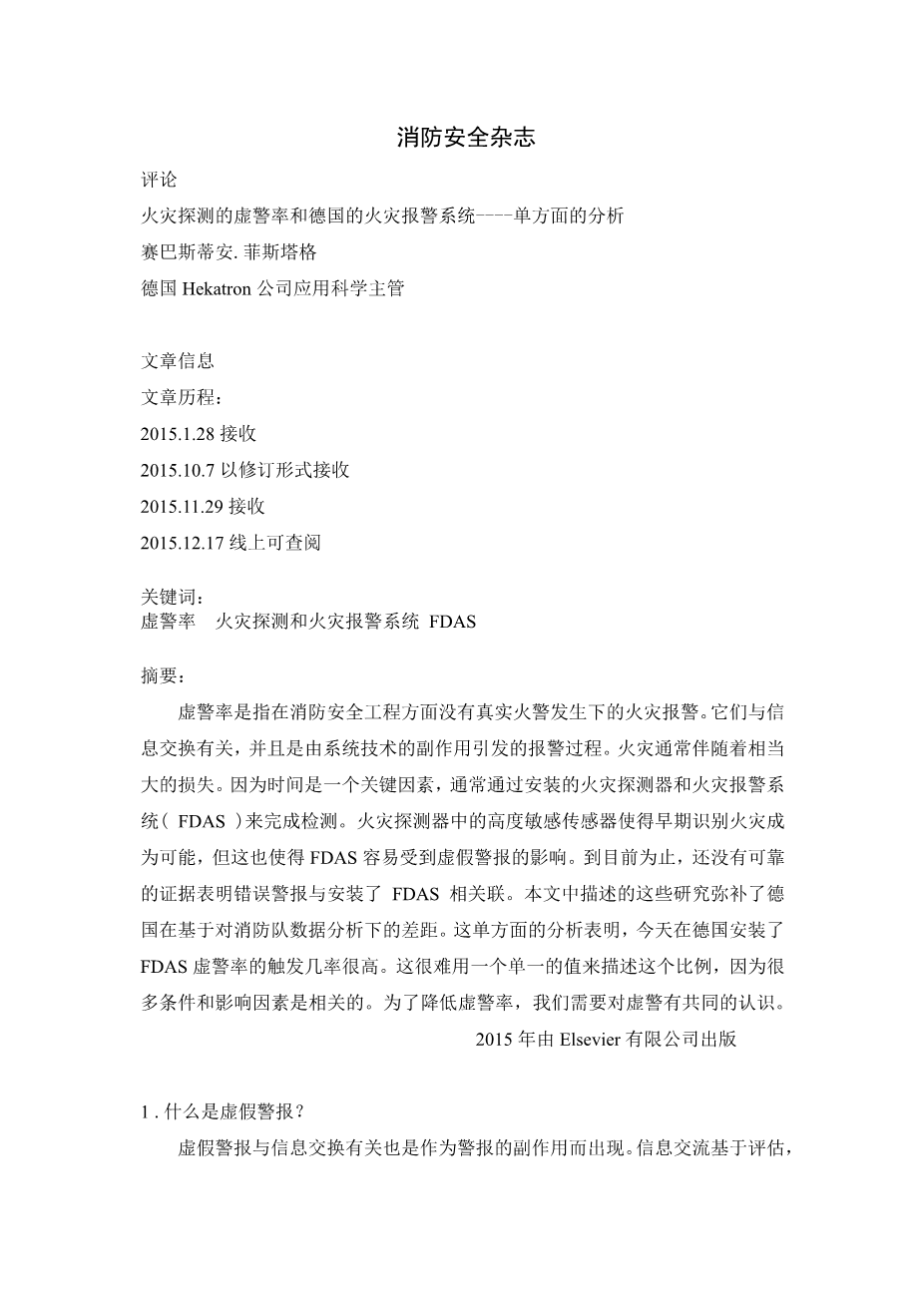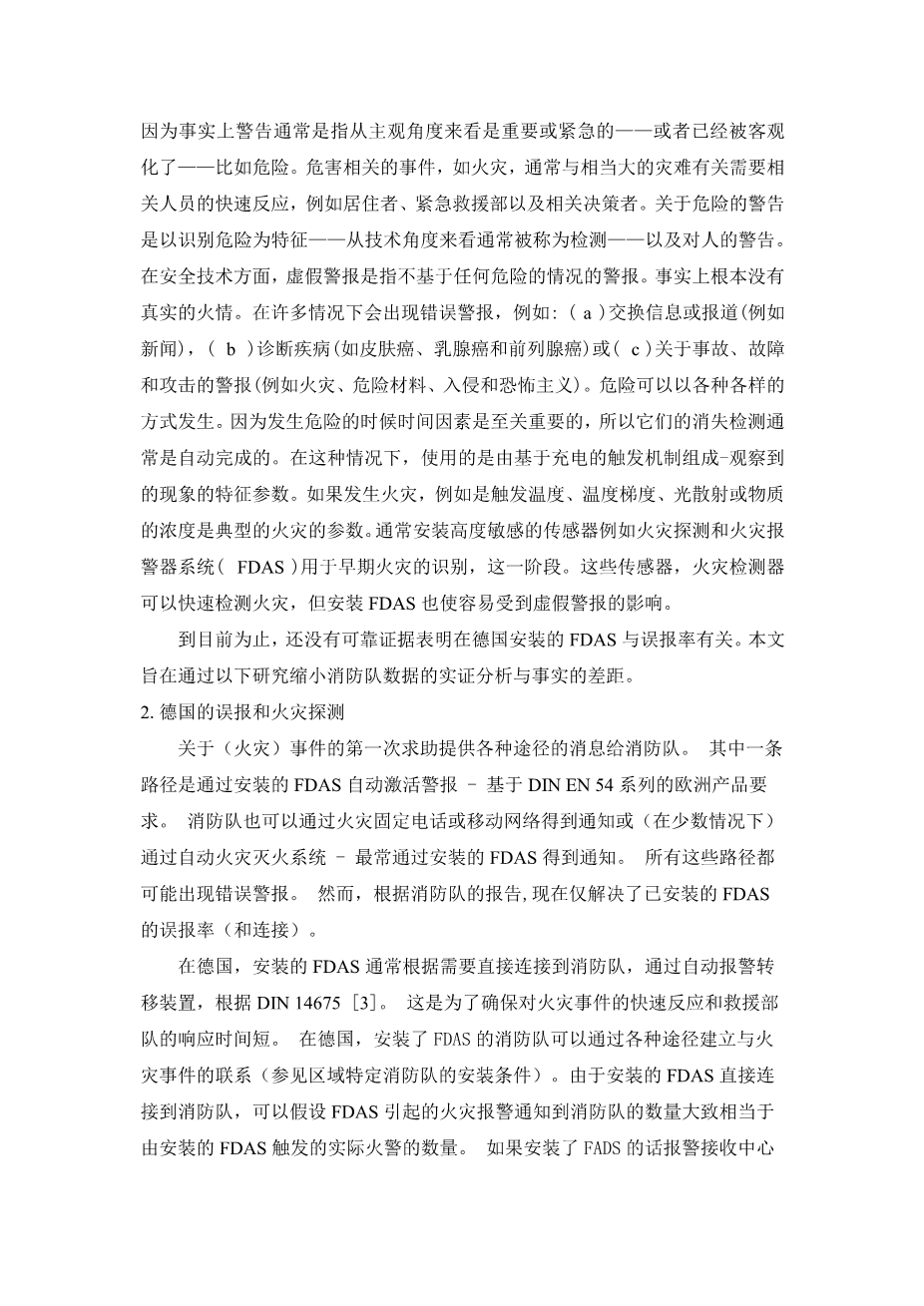Fire Safety Journal 79 (2016) 119–126
Contents lists available at ScienceDirect
Fire Safety Journal
journal homepage: www.elsevier.com/locate/firesaf
Review
False alarm ratio of fire detection and fire alarm systems in
Germany – A meta analysis
Sebastian Festag
Hekatron, Head of Applied Science, Germany
art ic l e i nf o
Article history:
Received 28 January 2015
Received in revised form
7 October 2015
Accepted 29 November 2015
Available online 17 December 2015
Keywords:
False alarm ratio
Fire detection and fire alarm systems
FDAS
a b s t r a c t
False alarms are – in terms of fire safety engineering – fire alarms in absence of a real fire condition. They
are related to the exchange of information and occur as a side effect of system technologies and the
alerting process. Fires often are associated with considerable damages. Because time is a critical factor,
detection is often accomplished by installed Fire Detection and Fire Alarm Systems (FDAS). The highly
sensitive sensors in fire detectors make the identification of fires in an early stage possible, but this also
makes FDAS susceptible to false alarms. So far there is no reliable evidence on the ratio of false alarms to
installed FDAS. The studies, which are described in the present paper, close this gap for Germany on the
basis of an empirical analysis of data from fire brigades. This meta-analysis show that today the false
alarm ratio triggered by installed FDAS (and connected to a fire brigade) is high in Germany. It is difficult
to describe the ratio in one single value, because a great number of conditions and influencing factors are
relevant. To reduce the false alarm ratio, we need a common understanding of false alarms and a con-
sistent use of terms and categories.
amp; 2015 Published by Elsevier Ltd.
Contents
1. What are false alarms? . . . . . . . . . . . . . . . . . . . . . . . . . . . . . . . . . . . . . . . . . . . . . . . . . . . . . . . . . . . . . . . . . . . . . . . . . . . . . . . . . . . . . . . . . . . . . . . 119
2. False alarms and fire detection in Germany. . . . . . . . . . . . . . . . . . . . . . . . . . . . . . . . . . . . . . . . . . . . . . . . . . . . . . . . . . . . . . . . . . . . . . . . . . . . . . . 120
3. Studies of the false alarm ratio of FDAS in Germany. . . . . . . . . . . . . . . . . . . . . . . . . . . . . . . . . . . . . . . . . . . . . . . . . . . . . . . . . . . . . . . . . . . . . . . . 121
3.1. Annual fire brigade statistics of the federal states. . . . . . . . . . . . . . . . . . . . . . . . . . . . . . . . . . . . . . . . . . . . . . . . . . . . . . . . . . . . . . . . . . . . 121
3.2. Data of three selected fire brigades . . . . . . . . . . . . . . . . . . . . . . . . . . . . . . . . . . . . . . . . . . . . . . . . . . . . . . . . . . . . . . . . . . . . . . . . . . . . . . . 122
3.3. Detailed operations data of a fire brigade . . . . . . . . . . . . . . . . . . . . . . . . . . . . . . . . . . . . . . . . . . . . . . . . . . . . . . . . . . . . . . . . . . . . . . . . . . 122
3.4. Fire loss statistics (pilot project, vfdb department 14). . . . . . . . . . . . . . . . . . . . . . . . . . . . . . . . . . . . . . . . . . . . . . . . . . . . . . . . . . . . . . . . . 123
3.5. Data of a professional fire brigade . . . . . . . . . . . . . . . . . . . . . . . . . . . . . . . . . . . . . . . . . . . . . . . . . . . . . . . . . . . . . . . . . . . . . . . . . . . . . . . . 123
4. Summary and meta-analysis. . . . . . . . . . . . . . . . . . . . . . . . . . . . . . . . . . . . . . . . . . . . . . . . . . . . . . . . . . . . . . . . . . . . . . . . . . . . . . . . . . . . . . . . . . . 124
5. Conclusion . . . . . . . . . . . . . . . . . . . . . . . . . . . . . . . . . . . . . . . . . . . . . . . . . . . . . . . . . . . . . . . . . . . . . . . . . . . . . . . . . . . . . . . . . . . . . . . . . . . . . . . . . 124
Appendix . . . . . . . . . . . . . . . . . . . . . . . . . . . . . . . . . . . . . . . . . . . . . . . . . . . . . . . . . . . . . . . . . . . . . . . . . . . . . . . . . . . . . . . . . . . . . . . . . . . . . . . . . . . . . . 125
References . . . . . . . . . . . . . . . . . . . . . . . . . . . . . . . . . . . . . . . . . . . . . . . . . . . . . . . . . . . . . . . . . . . . . . . . . . . . . . . . . . . . . . . . . . . . . . . . . . . . . . . . . . . . . 125
Glossary . . . . . . . . . . . . . . . . . . . . . . . . . . . . . . . . . . . . . . . . . . . . . . . . . . . . . . . . . . . . . . . . . . . . . . . . . . . . . . . . . . . . . . . . . . . . . . . . . . . . . . . . . . . . . . . 126
1. What are false alarms?
False alarms1 are related to the exchange of information and
E-mail address: fes@hekatron.de
1 The German term false alarm is often referred to as unwanted alarm, but in
the present context the two terms refer to different circumstances (see Fig. 1). For
example in the US the term unwanted alarm is used for the German term false
alarm. This varies from country to country. At the moment,
剩余内容已隐藏,支付完成后下载完整资料


英语译文共 10 页,剩余内容已隐藏,支付完成后下载完整资料
资料编号:[444172],资料为PDF文档或Word文档,PDF文档可免费转换为Word
以上是毕业论文外文翻译,课题毕业论文、任务书、文献综述、开题报告、程序设计、图纸设计等资料可联系客服协助查找。


